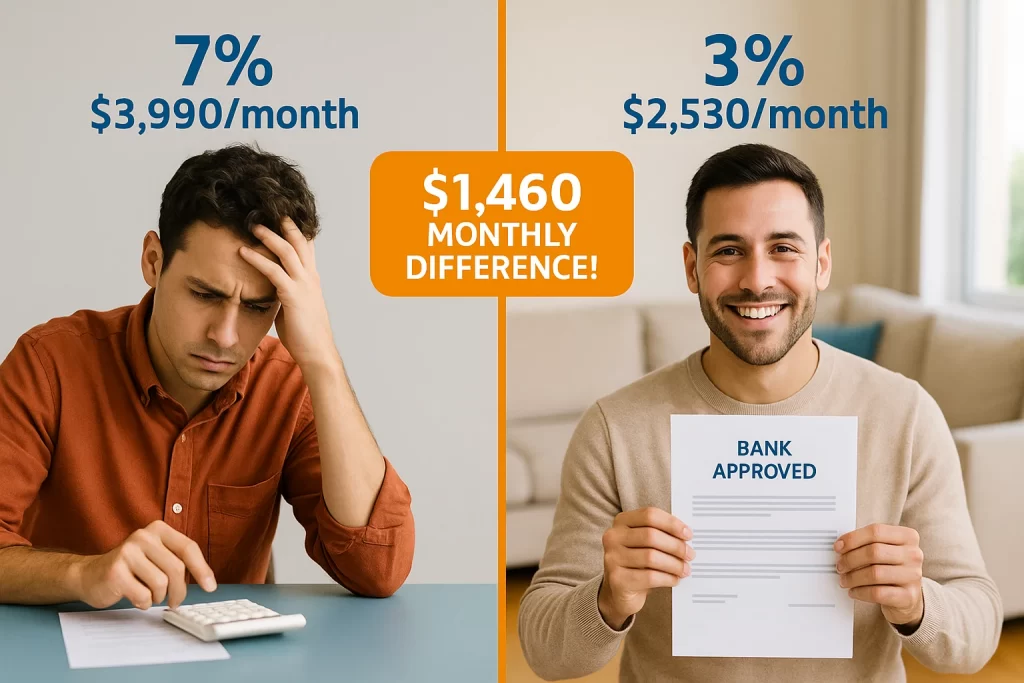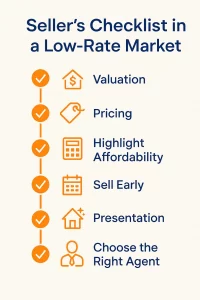How Interest Rate Drops in Mortgages Help You Sell Your House
TL;DR
- RBNZ OCR cuts are lowering mortgage rates, boosting affordability (RBNZ).
- Sales volumes rose 4% year-on-year in July 2025, signalling demand recovery (REINZ).
- Mortgage deals from 3.99% highlight competitive lending (RNZ).
- Banks forecast 3–7% house price growth through 2025–26 (ANZ, Kiwibank, Westpac).
- For sellers: lower rates mean faster sales, higher prices, and stronger competition.
Why Interest Rate Drops in Mortgages Matter for Sellers
How Interest Rate Drops in Mortgages Help You Sell Your House is the key question sellers are facing in 2025. On 20 August 2025, the Reserve Bank of New Zealand cut the Official Cash Rate (OCR) to 3.00%, the lowest in three years. This has already pushed down mortgage rates across major banks, signalling a shift in the housing market cycle.
When mortgages are cheaper, buyer affordability improves dramatically. More people qualify for finance, existing borrowers can refix at lower rates, and investors see stronger returns for homeowners, which translates into more buyer competition, shorter time on market, and higher offers.
In recovery phases like this, timing matters. Sellers who act early in the rate-cutting cycle can benefit from stronger demand before the market is flooded with listings. Marketing strategies that highlight buyer affordability and repayment savings can also attract motivated purchasers.
For homeowners, the bottom line is simple: falling mortgage rates don’t just help buyers—they can directly increase your chances of selling faster and at a better price.
How Mortgage Rates Respond to Interest Rate Drops
“Every time the RBNZ moves the OCR, it sends ripples through the mortgage market – interest rate drops in mortgages can swiftly lower borrowing costs across the board. On 20 August 2025, when the OCR dropped to 3.00%, banks immediately began adjusting lending rates.
- ANZ reduced floating and flexible loans by 20 bps, with floating now 6.29%–6.40% (RNZ).
- Westpac cut one- to two-year fixed terms by 4 bps, its three-year fixed by 30 bps, and its floating rate by 20 bps (NZ Herald).
- Kiwibank followed with a 20 bps floating cut (RNZ).
- The Co-operative Bank went further, dropping floating rates by 25 bps to 5.70% (Interest.co.nz).
The effect is striking. For a $600,000 mortgage:
- At 6.5%, repayments are about $3,800/month.
- At 5.0%, repayments fall to ~$3,220/month.
That’s a saving of $600 every month.
For sellers, this matters because it determines how many buyers can afford to enter the market. Lower rates = more approvals, more bidders, and more offers.
Buyer Affordability in a Low-Rate Market

Affordability is the backbone of housing demand. Even a small rate cut can transform whether buyers qualify for lending.
For a $600,000 mortgage:
- At 7%, repayments = ~$3,990/month.
- At 3%, repayments = ~$2,530/month.
That’s a $1,460 difference monthly.
In 2023, when rates peaked, affordability collapsed. Sales volumes fell and national house prices dropped 17% from their peak (REINZ). By contrast, the August 2025 cut has improved buyer sentiment, opening the door for first-home buyers, upgraders, and investors alike.
With more buyers eligible, sellers gain negotiating power. Auctions attract more bidders, conditional offers become easier to approve, and houses spend less time on market.
Data backs this up: in July 2025, sales volumes rose 4% year-on-year. The House Price Index edged up 0.1%, marking early stabilisation (REINZ).
The equation is clear: as mortgage costs fall, the buyer pool expands, strengthening seller outcomes.
Want to know how much your home is worth in today’s lower-rate market? Get a free valuation at PriceMyProperty.co.nz
Flow-On Effects: Mortgages → Sales Demand

The impact of lower mortgage rates extends far beyond the monthly repayment figure — it transforms buyer behaviour across the market. When mortgage costs fall, demand for property strengthens in visible and measurable ways.
One of the clearest signals is at property auctions. In high-rate markets, auctions often struggle to attract bidders, leaving properties passed in. But when rates fall, competition intensifies. Instead of one or two cautious bidders, auctions begin to draw multiple active buyers. This creates bidding wars that regularly push sale prices above the reserve.
Private treaty sales also see a marked shift. Lower rates mean more conditional buyers can secure mortgage approval, so their offers are more likely to go unconditional quickly. This gives sellers confidence that deals will proceed smoothly. The increase in approvals also means sellers receive a higher number of offers to choose from, strengthening their negotiating position.
Recent REINZ data backs this up. In July 2025, sales volumes rose 4% year-on-year, while the House Price Index increased 0.1%. These may sound like small numbers, but in a market that had been declining since 2022, they signal a turning point. Rising volumes show more buyers are re-entering, and stabilising prices suggest confidence is returning.
More buyers means more competition for your property — discover your potential sale price now with our instant free valuation at PriceMyProperty.co.nz .
For sellers, this flow-on effect is crucial. Lower mortgage rates don’t just help individual buyers — they lift the entire market by creating momentum. With more offers on the table, quicker turnarounds, and competitive bidding, sellers are in a stronger position to achieve their desired outcomes.
Why Sellers Benefit From Interest Rate Drops
Falling mortgage rates are often described as “buyer-friendly,” but in reality, they can be just as beneficial for sellers. Here are three ways sellers directly gain from lower interest rates:
- Higher sale prices.
When rates fall, buyers’ borrowing power increases. A buyer who could afford $700,000 at 7% interest may now afford $800,000 at 5%. This expanded capacity fuels competition and drives up prices. Sellers directly benefit from this upward pressure. - Shorter time on market.
Lower rates create urgency. Buyers who see affordability improve don’t want to risk missing out, especially if they expect further price growth. This urgency means homes spend less time on the market, reducing the stress and costs associated with extended campaigns. - Opportunity window.
In the early phase of a rate-cutting cycle, demand often rises faster than supply. Sellers who act quickly can take advantage of limited competition. As more homeowners recognise the improving market, listings typically increase, which can reduce the advantage. Acting early helps sellers maximise gains.
History proves the point. During 2020–2021, when mortgage rates dropped to record lows, sellers who listed early achieved premium prices. Those who waited often saw diluted demand as the market became saturated with new listings.
In 2025, the pattern is repeating. With the OCR at 3.00% and banks already reducing lending rates, demand is returning. Sellers who list now can capture buyer competition while supply is still catching up.
Selling in Different Rate Environments
Whether you’re selling in a low-rate or high-rate environment, the strategy matters.
Low-rate environment = Seller’s market.
When rates are low, buyers flood the market. Multiple offers, strong auctions, and rising prices are common. Sellers can afford to be selective, negotiate favourable terms, and achieve premium results. The focus should be on showcasing your property well and allowing competitive tension to drive price.
High-rate environment = Buyer’s market.
When rates are high, affordability shrinks. Buyer numbers thin out, sales campaigns take longer, and negotiations often favour the purchaser. In these markets, sellers must adjust strategy. Pricing realistically becomes critical, and investing in professional staging, photography, and marketing can make the difference in attracting scarce buyers.
For sellers, the lesson is simple: every market condition presents opportunities, but the approach must adapt. Knowing whether you’re in a low- or high-rate market allows you to position your property correctly and secure the best outcome possible.
What 2025’s Rate Cuts Mean for Homeowners
The RBNZ’s August 2025 cut to 3.00% marked a turning point. This is the lowest OCR in three years, and economists predict further easing toward 2.75% or even 2.50% in 2026 (Reuters).
Already, signs of recovery are appearing. REINZ reported that in July 2025, sales volumes increased 4% year-on-year, while the national House Price Index ticked up 0.1%. After two years of steady decline, this stabilisation is significant.
Banks are also optimistic:
- ANZ forecasts house price growth of 2.5% in 2025 and 5% in 2026.
- Kiwibank projects growth of 5–7% through 2026.
- Westpac expects prices to rise around 6% over two years (Reuters).
For homeowners considering selling, this means the tide has turned. Buyer confidence is returning, affordability is improving, and prices are forecast to rise. Acting now allows sellers to capture early gains before listings surge later in the cycle.
Should You Sell Now or Wait?
One of the toughest questions sellers face is timing. Should you sell now, or hold off for further price growth?
The case for selling now:
- Buyer demand is rising thanks to lower mortgage rates.
- Listings remain relatively limited, so sellers face less competition.
- Auctions and private sales are moving faster, with stronger offers.
The case for waiting:
- House prices are forecast to climb over the next two years.
- You may achieve a higher sale price if demand continues to build.
- Mortgage rates could fall further, drawing even more buyers into the market.
The risk with waiting is that more listings will also hit the market, reducing the seller’s competitive advantage. By contrast, selling now lets you capture today’s growing demand while supply is still tight.
The safest option is to get a professional property valuation. This gives you a clear picture of your home’s current market value and helps you weigh the benefits of selling today versus waiting.
Unsure of your home’s current value? Get a free property appraisal from PriceMyProperty.co.nz to help inform your decision.”
Seller’s Checklist in a Low-Rate Market
If you’re preparing to sell in today’s market, here’s a checklist to maximise your outcome:

- Get a fresh valuation. Lower rates may have lifted your property’s value.
- Set a competitive asking price. Align pricing with current buyer affordability to encourage multiple offers.
- Highlight affordability. Showcase how much cheaper repayments are today compared with last year. This speaks directly to buyers’ budgets.
- Sell early in the cycle. Don’t wait for a flood of listings — act while demand is climbing and competition among sellers is limited.
- Invest in presentation. Professional photography, staging, and minor renovations can deliver a significant return by helping your property stand out.
- Choose the right agent. Work with someone experienced in capitalising on low-rate markets, where auctions and multiple-offer scenarios can deliver premium results.
Not sure who to list with? My Top Agent helps you find the best real estate agents in your area. Get expert help. Contact a top local real estate agent through MyTopAgent.co.nz to discuss your selling strategy today.”
Following this checklist will position you to take full advantage of the current market shift, ensuring a faster sale, stronger offers, and less stress.
Conclusion
The recent drop in mortgage rates has created a rare opportunity for homeowners – interest rate drops in mortgages mean more buyers, faster sales, and potentially higher prices. As affordability improves, buyer numbers are climbing, auctions are becoming more competitive, and houses are spending less time on the market. While prices are only beginning to stabilise, forecasts suggest steady growth over the next two years. For sellers, acting early in this recovery phase offers the best balance of strong demand and limited competition.
Get your free property valuation now at PriceMyProperty.co.nz and discover how falling mortgage rates can help you sell faster and for more.
FAQs
- Do falling mortgage rates always push house prices up?
Not always, but they do create the conditions for stronger demand. Lower borrowing costs mean more buyers qualify for loans, which fuels competition. However, other factors—like job security, housing supply, and government policies—also influence prices. For example, while OCR cuts in 2025 have boosted demand, prices are only beginning to stabilise. - Is 2025 the right time to sell my property?
For many sellers, yes. The market is in an early recovery phase. According to REINZ, sales volumes rose 4% year-on-year in July 2025, while banks are forecasting steady price growth into 2026. Listing now means you benefit from rising buyer activity before competition from other sellers increases. - How soon do buyers return after interest rates drop?
Yes – interest rate drops in mortgages generally prompt buyers to re-enter the market quickly. The impact is often immediate. Borrowers on floating rates notice savings within weeks of a cut, while those refixing can secure lower repayments at their next term. First-home buyers also move quickly, as lower rates improve their ability to get loan approval. The result is a noticeable surge in buyer numbers at open homes and auctions. - Should I wait for more rate cuts before selling?
Waiting can be tempting, but there’s a risk. While further OCR cuts are expected, more homeowners will also list as confidence grows. Selling during the early stages of recovery means less competition, stronger buyer urgency, and faster sales.
Methodology
This article draws on data from New Zealand’s most reliable economic and housing sources. Monetary policy insights were taken from Reserve Bank of New Zealand OCR announcements. Housing market statistics came from the Real Estate Institute of New Zealand (REINZ), including sales volumes and the House Price Index. Broader economic context—covering inflation, unemployment, and growth—was sourced from Stats NZ. Forward-looking price forecasts were provided by ANZ, Kiwibank, and Westpac. Additional reporting came from RNZ, NZ Herald, Reuters, and Interest.co.nz.
Latest Post
- Appraisal vs Valuation in NZ: Registered Valuations, Online Estimates
- Auckland Property Market 2026: Simple Guide for Auckland Home Sellers
- OCR and House Prices NZ (2025–2026): Will Lower Rates Lift the Market?
- Christchurch property market 2025: the complete guide
- Best Renovations Before Selling in NZ: Smart Guide for Kiwi Homeowners




